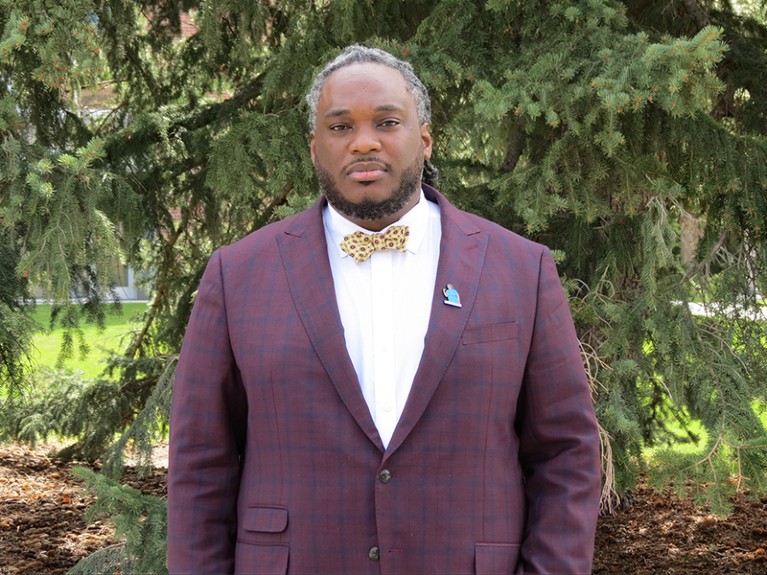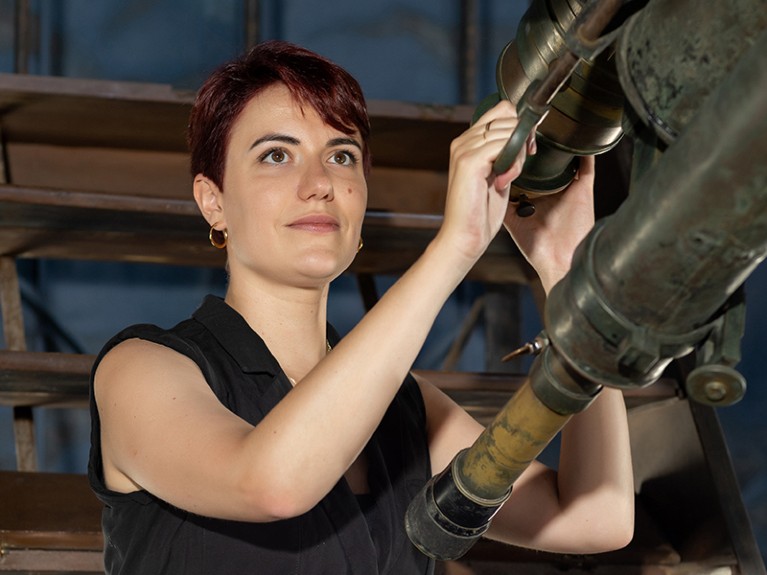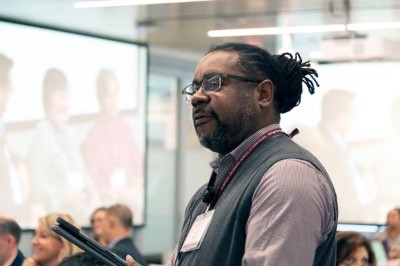
Credit: Getty
Scientific conferences can inspire researchers to take new directions in their work and help them to meet new employers and collaborators. The opportunities on offer are not, however, equally open to all. For scientists who are members of under-represented groups, conferences can be unwelcoming environments, where they are repeatedly interrupted, face hostile questioning, receive comments on their appearance, are excluded from leadership roles and worse because of their gender, skin colour or other aspects of their identity.
Nature speaks to four scientists about their experiences as members of under-represented groups at conferences — and how researchers can protect themselves and others from inappropriate behaviour, abuse and harassment.
PAS GARCIA MARTINEZ: When you’re in the minority, you feel different
Table of Contents
Optics researcher at the University of Valencia in Spain and general secretary of the Spanish Association of Female Researchers and Technologists.
In my university department, of 15 people who teach optical physics, I’m the only woman. At the conferences I go to, about 20–25% of the attendees are women. Being in a minority can feel isolating because you feel different. It’s about not having a sense of belonging and the unspoken codes of conduct at meetings.
You can see it in the way women ask questions differently from men; women often queue and wait for their turn, rather than pushing themselves forward. Speakers are mostly men, and female speakers are questioned more, or less respectfully.
I have experienced ‘mansplaining’ — when a man explains something to me in a patronizing way — at meetings many times. I’ve also been at meetings where I’ve described something, and then a man stands up and says the same thing in different words. I have suffered inappropriate jokes or comments about my physical appearance, such as my legs if I wear a skirt, or about my clothes. I like my male colleagues and have learnt a lot from them, but they can be competitive and sometimes speak in a way that is not welcoming to women.

Men dominate conference Q&A sessions — including online ones
Being in the minority at conferences is worse than in other professional situations because they are so important. As a researcher, you need to know what others in your field are doing, find out about interesting projects and be part of networks.
Event organizers can improve the situation. At some meetings, there are women-only sessions or lunches at which we can share experiences and provide support to each other. Younger women have told me that they don’t know how to respond when a man says something inappropriate, and women-only spaces are a good place to discuss such issues.
Travel can be a barrier for women because we tend to have more caring and family responsibilities. Grants and provisions for childcare can help. Many conferences became virtual as a result of the COVID-19 pandemic. That meant I could go to four international meetings per year, instead of just one. All meetings should have a virtual option to help women and other under-represented groups to attend.
Another way forward is requiring people to agree to codes of conduct that exclude all forms of harassment and discrimination when they register for meetings.
Sometimes we hear event-panel organizers say there are no women working in a particular area. Often, it is just that women have been excluded from the relevant networks. At the Association of Female Researchers and Technologists, which campaigns for equality for women in research, science and technology in Spain, we provide a database of more than 3,800 female researchers to increase women’s visibility to conference organizers and journalists.
I have been a working scientist for more than 20 years, and I’ve learnt that I must not be shy about putting myself forward when I want to do or say something. If need be, I speak louder to be heard. Women at earlier career stages should look to the other women at the meeting. If you experience any harassment or other bad conduct, tell organizers or other senior people. Be brave, don’t be afraid to ask questions and speak up.

Education and leadership researcher Sydney Freeman Jr.Credit: Ramon Tafoya
SYDNEY FREEMAN JR: It can be more about who you know
Education and leadership researcher at the University of Idaho in Moscow.
I have found that people of colour are minoritized in the broader group at meetings; however, what I find most challenging is that we are often under-represented in special-interest groups or subsections. Conferences might include groups that deal with increasing participation of scientists from certain racial or ethnic groups, in which there is advocacy for people of colour, which makes us feel included. But once you go to the group sessions in other areas — such as, in my field, the history of higher education or leadership and governance — it is often clearer that opportunities are more limited.
There are leadership opportunities, such as leading a special-interest group or serving on the board of the meeting. Often, researchers gain access to these groups through their networks: as in academia more broadly, it can be more about who you know than the quality of your work or how much work you’ve done.
My research focuses on college and university leadership and faculty, and the Black experience in higher education. I know every Black man who is a full-time faculty member in the field of higher education in the United States, because there are fewer than 40 of us out of 500–600 in total. Certain prestigious and well-resourced graduate schools with higher proportions of white students and faculty are well-represented at meetings. Their faculty members often have greater access to leadership positions, allowing them to provide their students and institutional colleagues with opportunities that are less likely to be open to people of colour.
These networks have power, and those in them are privileged at meetings. There are in-groups and out-groups, and people of colour often end up being boxed out. It’s informal and unspoken, which makes it harder for outsiders to navigate. It has taken me years, and it is still hard because I attended Oakwood University in Huntsville, Alabama — a small, liberal arts, historically Black university. Only later did I learn about the networking advantages of attending an elite institution — such as Harvard University in Cambridge, Massachusetts, or Yale University in New Haven, Connecticut — and that many people look down on those who didn’t study at one.
I once wanted to serve in a leadership position in a special-interest group related to studying university curricula, having done a lot of research on the topic. The group decided someone else should partner with me in the role. It’s not clear-cut whether I was discriminated against — but I was not working at a prestigious university, I was young and I am Black, and I think all those things worked against me.
These issues are often nuanced. Because white men normally dominate positions such as leadership of special-interest groups, members of under-represented groups sometimes end up helping only those in their own group and pushing out those from other groups. There can be competition between white women and people of colour, for example.
Leadership, including at meetings, has become more diverse, and there is heightened sensitivity that helps to ensure that panels are more diverse than in the past. The issues are, however, still there, and they are insidious. People of colour might not be overtly discriminated against, but certain opportunities will be open to us and to women only if we are willing to conform to standards set by white men.

Astronomer Lucie Leboulleux.Credit: L’Oréal-UNESCO For Women in Science foundation
LUCIE LEBOULLEUX: He said I didn’t have a sense of humour
Research associate at the CNRS in Grenoble, France, who works on the design of optical instruments used to image exoplanets.
In 2018, as a PhD student, I presented my work on the impacts of alignment errors in space-telescope segments in a poster session at a large astronomy meeting in the United States. I was speaking with several people in English, when a man around the age of 50 began asking questions in French in a way that excluded the others until they left. Over the next hour or so, he aggressively criticised my results, questioned my expertise and told me I didn’t know what I was talking about. Later, with colleagues, I burst into tears. I can’t know for sure why he spoke to me in that way, but I’m fairly certain it was because I am a woman or young, or both.
I heard a male PhD candidate at the same conference making sexist jokes and stereotypical comments about women. When I told him that his remarks weren’t funny, he said I didn’t have a sense of humour. Others later reported that the same man had touched at least four women’s bottoms and had asked several women for their phone numbers during a poster session.
Women make up about one-quarter of those attending the astronomy and instrumentation meetings that I go to. Thankfully, sexist jokes and unwanted touching are rare — but at every conference I go to, I see women being interrupted more frequently than men are. They are more likely to face hostile questioning, and, because they are often on the defensive, women ask fewer questions. Inappropriate behaviours can prevent women from expressing themselves, interacting freely and concentrating on their work.
In 2019, some colleagues and I conducted a survey on gender-based demographics and behaviours in the exoplanet direct-imaging community (L. Leboulleux et al. Bull. Am. Astron. Soc. https://doi.org/j7km; 2020). We found that 69% of female participants reported being treated differently at work or at a conference because of their gender, compared with 13% of men, and that 59% of women said they had been interrupted while talking or prevented from talking at a professional event, compared with 23% of men. We found that postdocs, who already face a lot of career pressure, were the most likely group to be the targets of inappropriate behaviours. Other research suggests this is also true for international researchers.
Meeting participants need to be vigilant for situations in which those in under-represented groups are being treated badly, and act as witnesses or allies if they can. Organizers should ensure there are clear codes of conduct at conferences and remind participants several times of what is not appropriate. I would advise women who find themselves in these situations at conferences to try to identify allies whom they can turn to if they need support.
Under-represented groups still face many problems at meetings, but at least discussing the subject is less of a taboo. Younger researchers talk about it more, and are more likely to call problems out than in the past. It is also encouraging that more people are thinking about how they can be allies to women, non-binary people and others in under-represented groups in these situations.
LEAH P. HOLLIS: Sometimes, it’s like I can’t win
Associate professor at Morgan State University in Baltimore, Maryland, whose research interests include bullying in the workplace and higher education, race, gender and student services.
We all know the story. If a woman or a Black person stands up and says something, and five minutes later a man or a white person says the exact same thing, it’s the person from the more powerful group, rather than the under-represented one, who is heard. If someone at an academic meeting is insecure or on a power trip, they might use it as an opportunity to run other people down, and they’re more likely to do that to women and to people of colour — especially to women of colour. It’s hard to divide race from gender, because often I’m not sure whether I’m facing resistance or hostility because I’m Black, a woman or a Black woman.

The time tax put on scientists of colour
Some people often talk about the ‘Black tax’: Black people have to arrive early, be the last to leave, publish more, take on more students and do two or three times as much work to get the same recognition as white people. But then sometimes, when you do so, you are punished for it. People get angry at me if I outperform them. If I’m complacent, some think I’m staying in my place. If I’m too vocal, have too many ideas and excel, then I’m exceeding their expectations, so they feel threatened, and I get punished for that. Sometimes, it’s like I can’t win.
At one meeting of a special-interest group at a higher education conference, I was an officer for the group, and the group coordinator insisted on deconstructing everything I did. She kept taking over and doing all of my tasks, such as writing a report or recording the meeting minutes. She just kept undercutting me; it was weird. Another time, I had a workshop co-facilitator who was being disrespectful, so I suggested that we use our academic titles, such as doctor or professor, to re-establish respect. She then said we should have a vote on what to call me. Historically, African Americans and Africans in the diaspora have always had someone trying to change our names or co-opt us — so that experience was disappointing and hurtful.
At some meetings, the environment is receptive to me performing as well as I can. At others, I can tell they want a token comment and a Black woman at the front when the web-page picture is taken to show how diverse the conference is. But then, in the actual meeting, it’s clear that I get one question, and if I keep asking questions or put forward ideas that might outshine somebody, I’ll piss people off.
I’m often very aware of my skin and gender, and I do a lot of calculating about where I should sit, who is leading the meeting and what the feeling in the group is. I’ll wait a long time before I say anything because I’m reading the room to see whether the people are hung up on race or gender, and I’m considering how I’ll be received. It can be exhausting.
To others in under-represented groups in these situations, I would say: stay balanced, and don’t let anyone ‘pull you off your square’. You have to read the room, think about who is going to support you, who your allies are and who is not going to support you, and decide how you want to offer your feedback. And remember, you are not the problem: it’s the nature of racism, sexism and intersectionality in our spaces.
